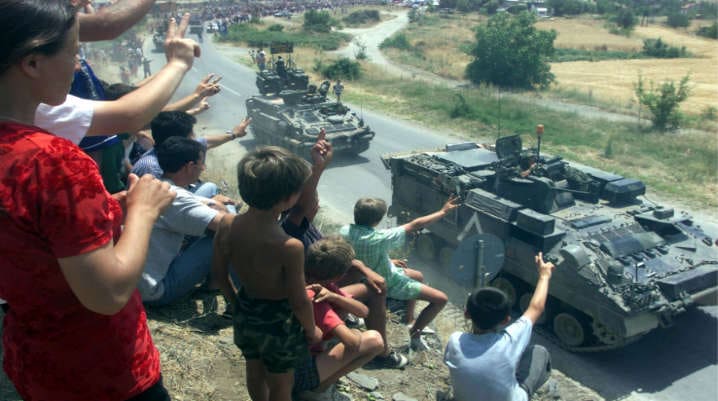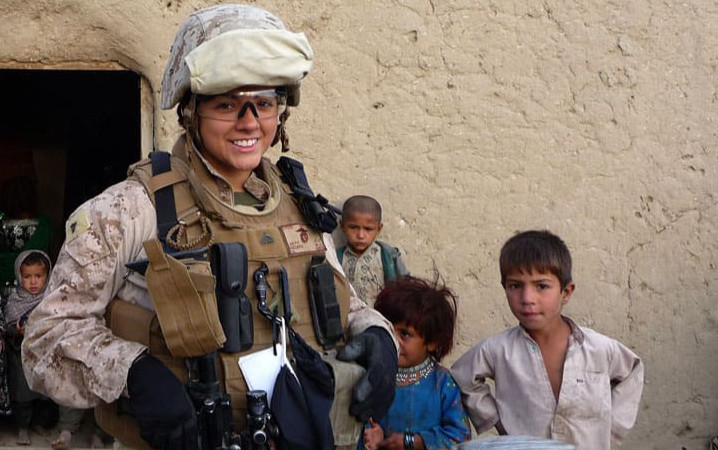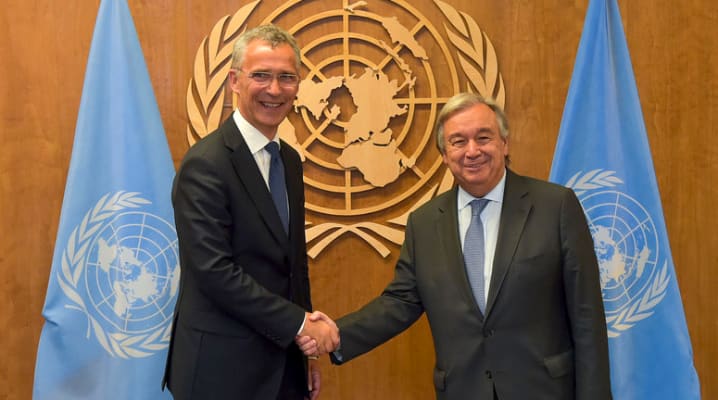NATO and the United Nations share strong bonds. Building on dialogue and cooperation developed after the end of the Cold War, a structured framework for cooperation was set out in a Joint Declaration agreed in September 2008.
Both NATO and the UN were conceived out of the same ethos of post-World War Two multilateralism and the two organisations share a deep-seated commitment to common values, with NATO’s founding document, the North Atlantic Treaty, making specific mention of the purposes and principles of the Charter of the United Nations. Nearly 70 years on, NATO’s core tasks continue to reflect this bond. Collective defence is rooted directly in Article 51 of the UN Charter, a UN Security Council mandate can be key to crisis management and cooperative security’s ultimate aim is to enhance international peace and security.
That said, the pragmatic interaction between NATO and the UN has not always reflected this strong normative alignment. During the Cold War, but also afterwards, political and bureaucratic realities presented acute obstacles to cooperation. A key milestone in breaking down some of these barriers was reached in September 2008 with the signing by the two Secretaries General of the Joint Declaration on UN-NATO Secretariat Cooperation (“Declaration”).

NATO has been leading a peace-support operation in Kosovo since June 1999, under the mandate of United Nations Security Council Resolution 1244, cooperating and coordinating with the United Nations, the European Union and other international actors. © NATO
The original case for a structured framework for NATO-UN cooperation and dialogue became increasingly apparent as the two organisations adapted to post-Cold War realities. Field-level contacts grew steadily in the Western Balkans and later Afghanistan, while NATO’s expanding network of partnerships opened up further space for interaction. The Alliance’s invigorated adaptability even saw it engaged in limited humanitarian-related support, including delivering aid to the victims of floods in Pakistan and escorting World Food Programme ships off the coast of Somalia.
In short, as NATO expanded the functional and geographic scope of its activities, it also expanded the possibilities for mutually beneficial cooperation with the UN and along with it, the case for a structural relationship. A natural reflex to seek and advance international partnerships was reinforced by a determined effort to promote interconnection, in the case of NATO through its ‘Comprehensive Approach’.
Expanding practical cooperation
Since the signing of the 2008 Declaration the practical interaction between NATO and the UN secretariats has expanded steadily, all the while navigating a careful course through political realities, financial limitations and bureaucratic incongruities. Not surprisingly, cooperation has flourished in areas of least political and organisational resistance.
Inclusive security has been a case in point. NATO has implemented UN Security Council Resolutions on Women, Peace and Security with vigour and has cooperated with UN Women and the UN Department of Peacekeeping Operations (DPKO) extensively in this regard. The same applies to Children and Armed Conflict and more recently the Protection of Civilians. On the latter subject, NATO consulted extensively with the UN in developing its own policy, and work is ongoing to develop joint training material.

NATO is implementing UN Security Council Resolutions on Women, Peace and Security, on Children and Armed Conflict and the Protection of Civilians with vigour, cooperating extensively with UN agencies in this regard. © NATO
NATO has also worked closely with the UN Office on Drugs and Crime (UNODC), particularly on counter-terrorism and counter-narcotics activities, and building integrity in the defence sector.
Cooperation has also slowly begun to bear fruit in the realm of UN peacekeeping. While this may appear to be an area where Alliance expertise could be of particular use to the UN, cooperation has been hampered by the two organisations’ vastly different operational set-up and geographical focus. NATO has briefed DPKO extensively on its training and exercise programmes and UN officials have participated in numerous Allied courses and exercises. NATO has also supported the UN in developing some of its own exercise material. Especially promising has been cooperation in the realm of countering improvised explosive devices (C-IED), with NATO (led by the C-IED Centre of Excellence in Madrid) engaging with the UN Mine Action Service on policy and training issues to help support the UN in upping its game to counter the number one killer of blue helmets.
Recognising the potential for cooperation on peacekeeping to expand further, NATO has been actively engaged with the UN in its latest round of peacekeeping reform. Consultations at NATO Headquarters in early 2015 helped the UN’s Independent High-Level Panel on Peace Operations to develop its influential report. In another milestone in the NATO-UN relationship, Secretary General Stoltenberg participated in the Leaders’ Summit on Peacekeeping in the margins of the historic 2015 UN General Assembly, where he pledged continuing NATO support to UN peacekeeping. Since then, the Alliance has participated in two UN Defence Ministerial meetings (London 2016, Vancouver 2017) and a number of promising areas for further cooperation with the UN Secretariat have been identified.
Deepening dialogue
Alongside expanding practical cooperation, the past decade has seen political dialogue between the two organisations evolve into a key element of interaction. Regular exchanges between Secretaries General down to the working-level have become a mainstay feature of the relationship, with annual staff talks used to review the state of play of relations and scope new areas of cooperation at the level of senior management.
The 2008 Declaration also saw the addition of a permanent NATO civilian liaison officer to the UN Headquarters in New York to complement the work of the military liaison. This post has greatly facilitated not only the flow of information and the navigation of complex bureaucracies, but is a vital multiplier to the important role that dialogue plays in demystifying what NATO is and does in a broader UN ecosystem where many still hold misconceptions about the Alliance.

NATO Secretary General Jens Stoltenberg (left) and UN Secretary-General António Guterres are committed to further develop NATO-UN cooperation and dialogue to better reflect strategic priorities in the evolving security environment. © NATO
Considering that nearly nothing of the above existed before the 2008 Declaration, it is safe to call the past decade of the NATO-UN relationship a success. It is equally evident, however, that the strategic priorities of the two organisations have shifted together with the changes in the global and regional environments in which they operate.
Evolving to reflect new realities
For NATO-UN cooperation and dialogue to remain meaningful, it must continue to evolve. Several recent initiatives already reflect new and evolving realities. For example, in the context of NATO’s Projecting Stability agenda a dialogue on potential cooperation has begun with the UN’s new Office of Counter Terrorism. Similarly, exploratory talks are being held on how NATO’s Building Integrity work could potentially complement the UN’s broader defence sector reform activities.
And as UN Secretary-General Guterres pushes his Action for Peace agenda, NATO is looking at how it can add value to the broader network of UN partnerships and share its expertise to make UN peacekeeping more effective. Promising areas include sharing standards and best practices, military medicine and training support through NATO’s Partnership Training and Education Centres. Moreover, cooperation on inclusive security issues still has plenty of untapped potential. So there is plenty of substance to drive the NATO-UN relationship into the next decade.
While noting past successes and exploring future cooperation, it is also important to manage expectations. The mandate of the United Nations, even when confined strictly to its secretariat, remains vastly broader than that of NATO – its geographic focus lies mostly beyond NATO’s horizons and its global membership dictates political realities that will always limit cooperation to some extent. Indeed, improving the NATO brand in New York remains an important work in progress. That said, a successful United Nations is eminently in NATO’s interest and greater dialogue and cooperation adds clear value to both organisations. The task ahead for the two secretariats is to keep pushing the boundaries of what is possible and to turn this ambition into more concrete results.
